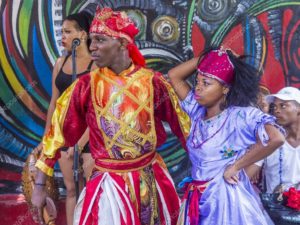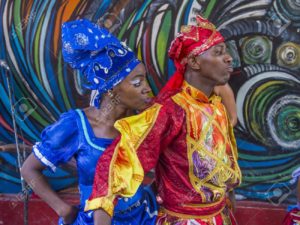THE CUBAN RUMBA. HISTORY OF ITS DIFFERENT STYLES. PHOTOS / VIDEOS

Rumba is a secular genre of Cuban music involving dance, percussion, and song. It originated in the northern regions of Cuba, mainly in urban Havana and Matanzas, during the late 19th century. It is based on African music and dance traditions, namely Abakuá and yuka, as well as the Spanish-based coros de clave.
Formerly the Cuban rumba was a dance of the most humble class, mainly of blacks and mulattoes who lived in the Havana lots. These communities are located in the heart of Havana and are nothing more than dismantled mansions that establish a collective, bustling lifestyle of picturesque neighborhood styles.
The rumba and drum beats are part of daily life in these places that, in turn, keep the most deeply-rooted identity of the Cuban. And although the birthplace of the rumba is solar, its contagious rhythm and dance transcended the poor stages of the marginal neighborhoods and conquered the tracks of important nightclubs and theaters throughout the country.
As time progressed, it developed, acquiring greater musical representatives and finally reaching society. This style managed to climb into Cuban culture until it became an intangible cultural heritage of humanity, declared this way by UNESCO in 2016.
Today it is heard everywhere: the same in a lot in Galeano, in the Callejón de Hamel, in a central park in Matanzas, or in the carnivals of Santiago. The rumba is formed in a corner, in a house, and even in elegant halls.
In addition, numerous festivals take place throughout the island such as the Caribbean Festival (held in the first week of July), the Rumba Route (organized every summer by the Timbalaye institution), or the Wemilere Festival of Guanabacoa.
OUR RUMBA AROUND THE WORLD
But our rumba has also become a tourist attraction, exported to various corners of the world. It has come to Barcelona with the Guaguancó Festival and to Strasbourg with the Rumba and Candela festival.
Cuban rumba can be classified into three fundamental styles: the Yambú, the Columbia, and the Guaguancó.
YAMBÚ
It is the oldest of all and comes from the urban suburbs in the province of Matanzas. It is danced in pairs, with slow and studied movements. The center of attention is the dancer, who shows off with discreet pelvic movements and flirts with the man all the time.
COLUMBIA
He comes from the rural areas of Matanzas but has a strong Congolese influence. It is a faster rhythm and is used for a single dancer – usually the man – to show his abilities.
Whoever interprets the dance interacts with the musician of the tumbadora and executes the steps upright from him, with movements of arms and legs along with the typical undulations of the hip. Acrobatics and pantomimes are used between his steps. Flaunting his virility and prowess in dance, he often incorporates objects such as knives, machetes, or bottles on the floor.
GUAGUANCÓ
Born in the black neighborhoods of Havana, he is the most elaborate of the three, the most erotic and the most danced. The man dances trying to conquer the woman, with a pelvic movement that simulates a sexual encounter. This step is known as “vaccinating.”
The woman, on her part, moves in a more subtle way, with sensuality and mischief. She tries to evade her partner and resists her attacks with a gesture where she covers her crotch with her skirt or with her hands. Although she rejects the man, the dancer continues the dance prompting him and provoking him to continue the flirting.
LA RUMBA CUBANA. HISTORIA DE SUS DIFERENTES ESTILOS. PHOTOS/VIDEOS
La rumba es un género secular de música cubana que incluye danza, percusión y canto. Se originó en las regiones del norte de Cuba, principalmente en las zonas urbanas de La Habana y Matanzas, a fines del siglo XIX. Se basa en las tradiciones de danza y música africanas, a saber, Abakuá y yuka, así como en los coros de clave españoles.
Antiguamente la rumba cubana era un baile de la clase más humilde, principalmente de negros y mulatos que vivían en los solares habaneros. Estas comunidades se ubican en el corazón de La Habana y no son más que mansiones desmanteladas que establecen un estilo de vida colectivo, bullicioso y de pintorescos estilos vecinales.
Los golpes de rumba y tambor son parte de la vida cotidiana en estos lugares que, a su vez, guardan la identidad más arraigada del cubano. Y aunque la cuna de la rumba es el solar, su contagioso ritmo y baile trascendieron los escenarios pobres de los barrios marginales y conquistaron las pistas de importantes clubes nocturnos y teatros de todo el país.
Conforme fue avanzando el tiempo, fue desarrollándose, adquiriendo mayores representantes musicales y logrando calar finalmente en la sociedad. Este estilo logró treparse en la cultura cubana hasta convertirse en patrimonio cultural inmaterial de la humanidad, declarado así por la Unesco en 2016.
 VIDEOS – BAILANDO RUMBA CUBANA
VIDEOS – BAILANDO RUMBA CUBANA
Hoy se escucha por doquier: lo mismo en un solar de Galeano, en el Callejón de Hamel, en un céntrico parque de Matanzas o en los carnavales de Santiago. La rumba se forma en una esquina, en una casa y hasta en elegantes salones.
Además, numerosos festivales tienen lugar a lo largo de la Isla como el Festival del Caribe (celebrado en la primera semana del mes de julio), la Ruta de la Rumba (organizado cada verano por la institución Timbalaye) o el Festival Wemilere de Guanabacoa.
NUESTRA RUMBA POR EL MUNDO
Pero nuestra rumba se ha convertido, además, en una atracción turística, exportada a varios rincones del orbe. Ha llegado hasta Barcelona con el Festival del Guaguancó y hasta Estrasburgo con el festival Rumba y Candela.
La rumba cubana se puede clasificar en tres estilos fundamentales: el yambú, la columbia, y el guaguancó.
YAMBÚ
Es el más antiguo de todos y proviene de los suburbios urbanos en la provincia de Matanzas. Se baila en pareja, con movimientos lentos y estudiados. El centro de atención es la bailarina, quien se luce con movimientos pélvicos discretos y coquetea al hombre todo el tiempo.
COLUMBIA
Proviene de las zonas rurales de Matanzas, pero tiene una fuerte influencia congolesa. Es un ritmo más acelerado y se utiliza para que un solo bailarín -normalmente el hombre- muestre sus capacidades.
Quien interpreta el baile interactúa con el músico de la tumbadora y ejecuta sus pasos erguido, con movimientos de brazos y piernas junto a las típicas ondulaciones de cadera. Entre sus pasos se emplean acrobacias y pantomimas. Haciendo alarde de su virilidad y destreza en el baile, suele incorporar objetos como cuchillos, machetes o botellas en el piso.
GUAGUANCÓ
Nacido en los barrios negros de La Habana, es el más elaborado de los tres, el más erótico y el más bailado. El hombre danza intentando conquistar a la mujer, con un movimiento de pelvis que simula un encuentro sexual. Este paso se le conoce como «vacunao».
La mujer, por su parte, se mueve de forma más sutil, con sensualidad y picardía. Intenta evadir a su pareja y se resiste a sus ataques con un gesto donde cubre su entrepierna con la saya o con las manos. Aunque rechaza al hombre, la bailarina continúa la danza incitándolo y provocándolo a seguir el coqueteo.
Agencies/ Wiki/ CubaGo/ Amalia Triana/ Internet Photos/ YouTube/ Arnoldo Varona/ Videos/Photos- Historia de Cuba
THE CUBAN HISTORY, HOLLYWOOD.



 THE CUBAN RUMBA. History of its Different Styles. PHOTOS / VIDEOS. * LA RUMBA CUBANA. Historia de sus Diferentes Estilos. PHOTOS / VIDEOS
THE CUBAN RUMBA. History of its Different Styles. PHOTOS / VIDEOS. * LA RUMBA CUBANA. Historia de sus Diferentes Estilos. PHOTOS / VIDEOS




